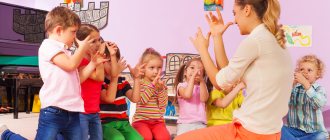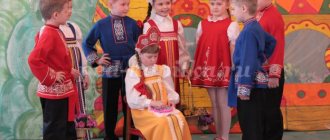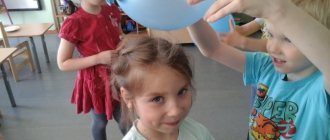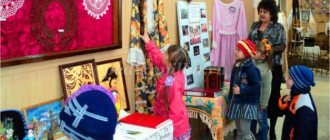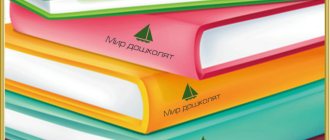Development of children's cognitive activity through children's experimentation (from work experience)
Author: Nekrasova Irina Vasilievna
Development of children's cognitive activity through children's experimentation
(from work experience)
Nekrasova Irina Vasilievna
Teacher of MDOBU No. 53 “Ryabinka”
P. Chunsky
In accordance with the Federal State Educational Standard for Educational Education, the focus of teachers’ attention should be on the orientation of the educational process towards the cognitive capabilities of the preschooler and their implementation. It is necessary to organize interaction with the child in such a way that it is aimed at developing cognitive interest, cognitive independence and initiative.
Cognitive development involves the cognitive activity of a preschooler. And in order to support cognitive activity, it is necessary to rely on the cognitive interest of children.
The baby is a natural explorer of the world around him. The world opens up to the child through the experience of his personal feelings, actions, and experiences. An unquenchable thirst for new experiences, curiosity, a constant desire to observe and experiment, to independently seek new information about the world, are traditionally considered as the most important features of children's behavior. Satisfying his curiosity in the process of active cognitive and research activity, which in its natural form manifests itself in the form of children's experimentation, the child, on the one hand, expands his ideas about the world, on the other hand, begins to master the fundamental cultural forms of ordering experience: cause-and-effect, genus-species, spatial and temporary relationships that make it possible to connect individual ideas into a holistic picture of the world.
The development of children's cognitive activity is one of the pressing problems of our time. By developing cognitive activity in preschool children, we develop children's curiosity and desire to engage in search activities, namely experimentation. The more varied and intense the search activity, the more new information the child receives, the faster and more fully he develops.
Children's experimentation is quite easily integrated into many types of children's activities.
A decisive role in working with children is played by organized educational activities with a clearly defined problem or “solving problem situations” or elements of experimentation. This allows children to develop cognitive activity, the ability to put forward hypotheses, compare, and draw conclusions independently or with the help of an adult; ideas about objects and phenomena are also specifically formed and, through experience or an experiment, proves the authenticity of the knowledge and ideas acquired by children.
I use thought experiments (or games) quite widely in children’s research activities. Such games help children acquire skills in exploratory behavior and development of thinking: the ability to see problems and put forward hypotheses for their solutions.
I implement one of the interesting ways to develop children’s research activities in artistic and productive activities, namely in the use of non-standard drawing techniques (with fingers, with a brush, with cellophane, on wet paper, with air through a straw), and experiments with various materials. In the process of such activities, children learn and better remember the properties of these objects and substances. Applique allows you to use threads, fabric, cotton wool, natural materials, which at the same time allows children to study their properties, composition, and capabilities.
In musical activity, the process of experimenting with sound material develops children's initiative, arbitrariness and creativity of the child's personality, and contributes to the development of intellectual competence. Children learn to find sound associations, group sounds based on common features, and match sounds with verbal definitions. Experiments are carried out in search of the sounds of the city and countryside; searching for associations when working with the sounds of nature (the rustling of leaves is reproduced by rustling paper, the singing of a tit by tapping on a crystal glass), in the sound of musical works, when making sound toys, noisemakers. All this activity is playful and entertaining in nature.
Experimental activity during observations of natural phenomena or objects involves consolidating knowledge or understanding the connections between what is happening. Observing on walks, in a corner of nature, in the surrounding reality, I plan short-term experiments relevant to the topic. For example, if there is hail, you and your children should definitely check whether these are really pieces of ice, how quickly it will melt on our palms, and whether the water will be clean. In some cases, the opposite happens, we first set a search task, and an observation follows from it: find traces of autumn, find the lowest place on the site
As part of my work, I carry out the main work on studying the conditions necessary for plant life. I continuously and gradually increase this amount of knowledge through experiments and observations in nature and in corners of nature. Children develop stable knowledge about the connection between plants and human care for them. From this point on, experimentation with plants begins. Individual experiments help you remember what the soil consists of and why it needs to be loosened; how plants depend on heat, light (during growing seedlings, germinating seeds). In winter, while clearing snow, we talk with preschoolers about the protective properties of snow. In autumn, during leaf fall, children find out how the weather affects its intensity, and while harvesting leaves, they can find out why the leaves rustle and sometimes not.
To develop children's cognitive activity and maintain interest in experimental activities, the group has an ecological corner and a mini-laboratory, which is constantly replenished with materials and equipment in accordance with the age of the children and the number of experiments performed.
The mini-laboratory has the necessary equipment for conducting experiments and research activities:
Ø assistant devices: magnifying glasses, scales (scales), hourglasses, compass, magnets;
Ø a variety of vessels from various materials (plastic, glass, metal) of different volumes and shapes;
Ø natural material: pebbles, clay, sand, shells, bird feathers, cones, saw cuts and tree leaves, moss, seeds, etc.;
Ø waste material: wire, pieces of leather, fur, fabric, plastic, wood, cork, etc.;
Ø technical materials: nuts, paper clips, bolts, nails, cogs, screws, construction parts, etc.;
Ø different types of paper: plain, cardboard, sandpaper, copy paper, etc.;
Ø dyes: food and non-food (gouache, watercolors, etc.);
Ø medical materials: pipettes, flasks, wooden sticks, syringes (without needles), measuring spoons, rubber bulbs, etc.;
Ø other materials: mirrors, balloons, butter, flour, salt, sugar, colored and clear glass, nail file, sieve, candles, etc.
When equipping the mini-laboratory, the following requirements were taken into account:
Ø safety for the life and health of children;
Ø sufficiency;
Ø accessibility of location.
It is necessary to train children to act in the experimentation corner; experiments are organized according to the wishes of the children, but at the same time they clarify what they want to get, but do not interfere with the course. Let the child try and make mistakes, but independently find a solution and achieve results.
Gradually, elementary experiments become experimental games, in which, like didactic games, there is an educational part and an entertaining one.
In the book corner there are children's reference books, encyclopedias on various topics, beautifully illustrated, with good, concise and informative texts accessible to children, and children's fiction.
A card file of tasks and exercises aimed at developing children’s ability to see a problem, put forward a hypothesis, ask questions, define concepts, draw conclusions and conclusions.
Properly organized experimental activities make it possible to satisfy children’s need for new knowledge and impressions, and contribute to the upbringing of an inquisitive, independent, successful child.
The gaming environment gives children the opportunity to freely express their inclinations without violating the norms of generally accepted behavior. The group has created play “centers” that promote full communication between children, satisfying each child’s need for movement, the desire to play, draw, and sculpt.
Children's experimentation is the basis of search and research activities of preschoolers. The main advantage of using the experimentation method in kindergarten is that during the experiment:
· Children get real ideas about the various aspects of the object being studied, about its relationships with other objects and with the environment.
· The child’s memory is enriched, his thought processes are activated, as the need constantly arises to perform operations of analysis and synthesis, comparison and classification, generalization and extrapolation.
· The child’s speech develops, as he needs to give an account of what he saw, formulate discovered patterns and conclusions.
· There is an accumulation of a fund of mental techniques and operations that are considered as mental skills.
· Children's experimentation is also important for the formation of independence, goal setting, and the ability to transform any objects and phenomena to achieve a certain result.
· In the process of experimental activities, the child’s emotional sphere and creative abilities develop, work skills are formed, and health is improved by increasing the overall level of physical activity.
I am conducting experimental work in three interrelated areas:
· wildlife (characteristic features of the seasons, diversity of living organisms as adaptation to the environment, etc.);
· inanimate nature (air, water, soil, light, color, heat, etc.);
· man (functioning of the body, man-made world: materials and their properties, transformation of objects).
Pupils of the group enjoy creating various compositions and decorations from pebbles, building fairy-tale palaces, while studying the properties of stones and their diversity.
When working with soil, children become real soil researchers. They study why people and plants need soil, how to make it soft and fertile. They curiously look into a special glass house in the hope of seeing an earthworm chewing leaves.
Also, the necessary conditions have been created to study such a phenomenon as air. Here preschoolers study air: they learn to blow bubbles and catch them in bags, and explore its properties.
Children enjoy experimenting with water. They especially like to change its color, taste, and conduct experiments with snow and ice.
The most interesting experiments for children were such experiments with water as: “If you freeze water in a bottle”, “Why do icicles grow upside down? How do they grow?”, “Which ice melts faster: crushed ice or sheet ice?”, “Why does dirty and colored ice melt faster?”, “Not all substances dissolve in water.”
In the course of conducting research with air, children gain knowledge about the properties of air, discover it in space, inside a person, in surrounding objects; consider the need for air for all living things; they learn that air takes up space and has power; They find out how wind is formed, that warm air is lighter than cold air and rises.
When learning about the properties of sand, children examine the sand through a magnifying glass, observe and describe the grains: they are round, yellow, some are transparent, as if made of glass, all the grains lie separately from each other. Then they create a “desert storm” by blowing through a straw into a jar of sand. Children come to the conclusion that the grains of sand are not connected to each other, so the sand is loose and crumbly.
Children also really enjoy experiments that introduce them to magnets and their properties. Thus, during the educational activity “This Amazing Magnet”, children identify materials that interact with magnets, get acquainted with the properties of a magnet - the passage of magnetic forces through various materials and substances; reveal such a feature in the interaction of two magnets as attraction and repulsion, the ability of metal objects to be magnetized.
In order for the child, after conducting experiments together with the teacher, to be able to independently continue research on the topic being studied, the group has everything for experimentation in a place accessible to children.
It is known that not a single educational or educational task can be successfully solved without fruitful contact with the family and complete mutual understanding between parents and teacher. Therefore, we work in close cooperation with the parents of the pupils.
Long-term observation of a child in a new environment allows parents to take a different look at him and at raising him at home. Parents are also provided with consultations on research activities; advice to parents on “How to help a little researcher” has been developed.
After experimentation classes, children are happy to tell their parents about their discoveries, perform the same and more complex experiments at home, learn to pose problems, put forward hypotheses and solve them independently. Many of them began searching for interesting materials for carrying out experiments. Experimenting at home with your child has become a fun activity for the whole family.
Used Books:
1. Dybina O. In The unknown is nearby: entertaining experiences and experiences for preschoolers /Text/ O.V. Dybina, N.P. Rakhmanova, V.V. Shchetinina. –M.: Sphere shopping center, 2005.
2. Ivanova A.I. Natural science observations and experiments in kindergarten. Plants. /Text/: children's encyclopedia/ A. I. Ivanova – M.: Sphere shopping center, 2004.
3. Prokhorova L. N. Organization of experimental activities of preschoolers. Guidelines. – M.:ARKTI, 2004.
4. Ryzhova N. A. Sorceress – Water /Text/ N. A. Ryzhova. – M.: Linka-Press, 1997.
5. Ryzhova N.A. Games with water and sand // Hoop, 1997. - No. 2. 8. Ryzhova N.. Experiments with sand and clay // Hoop, 1998. - No. 2.
6. Tugusheva G.P., Chistyakova A.V. Game-experimentation for children of senior preschool age // Preschool pedagogy, 2001. - No. 1.
7. Internet resources
comments powered by HyperComments
Experimentation as a means of developing the cognitive activity of a preschooler
Ryabkina Irina Nikolaevna Denisova Yulia Sergeevna teachers Goltsova Marina Vyacheslavovna physical education instructor MBDOU kindergarten No. 16 “Ivushka”
Popular wisdom says, “It’s better to see once than to hear a hundred times,” and practical teachers say, “It’s better to experience it once, try it, do it yourself.”
Preschool children are by nature inquisitive explorers of the world around them. Throughout preschool childhood, along with play activities, cognitive activity, as a process of acquiring knowledge, skills, and abilities, is of great importance in the development of a child’s personality. The teacher’s task is not to stop, but rather to actively help.
When we develop cognitive activity in preschool children, children's curiosity develops along with it. To prove this, we can rely on the words of N.N. Poddyakov: “The reasons for the intellectual passivity of children that occur often lie in the limitations of their intellectual impressions and interests.” In his opinion, children’s experimentation is a special form of search activity of preschool children, in which children’s own activity is manifested, aimed at obtaining new information and knowledge [17].
Currently, according to the Federal State Educational Standard, the pedagogical task is to create optimal conditions under which each child could develop and improve their abilities in discovering the features and properties of objects in the surrounding reality [3].
Advertising message
In experimental activities in preschool educational institutions, the teacher has a goal: to form and expand children’s ideas about objects of living and inanimate nature through practical independent knowledge.
In order to arouse the interest and cognitive activity of children and achieve the goal, we set the following tasks:
- Draw children's attention to participate in research and generalize the results of experiments.
- Select educational and playful material with environmental content, taking into account their age and individual characteristics.
- To form the foundations of a holistic worldview in children through children's experimentation.
- Promote the development of cognitive activity, curiosity, the desire for independent knowledge and reflection, the development of mental abilities and speech.
In the process of experimentation, the teacher should act for children not as a teacher, but as an equal partner, directing children’s activities in the right direction. Knowledge that is not told by a teacher, but acquired independently, is always conscious and more durable.
The experimental activities of preschoolers received a new impetus in development with the introduction of the Federal State Standard for Preschool Education. The requirements for a kindergarten graduate highlight the following integrative qualities:
- Interested in new, unknown things in the world around him.
- Loves to experiment.
- Takes a lively, interested part in the educational process [25].
Understanding the importance of experimentation for the mental development of a child and working according to the “Childhood” program, we equipped the experimental activity center with the necessary equipment and materials to implement the work we propose. This allows the teacher to work with children in small interest groups and use materials that are often not used in a group with a large number of children. We try to replenish our center with new items as often as possible. We put them at the disposal of children, who encourage our young researchers to experiment with the use of these materials. This preserves children’s interest in this activity and develops curiosity [37].
When organizing research activities, we make sure to use ICT. After all, it allows children to develop their ability to navigate the information flows of the world around them, master practical ways of working with information, and develop skills that allow them to exchange information using modern technical means.
During the day, during different regime moments, we use various forms of organizing children's experimentation. Children love surprise moments and problematic situations. Any experimental activity takes place under adult supervision and subject to certain safety rules.
In our work on organizing educational and research activities, we share not only with colleagues, but also with the parents of our students. We recommend making observations, traveling together, having conversations, watching educational programs, cartoons, and reading educational literature. After all, we, teachers, must become competent assistants for parents in creating not only a subject environment, but also acquainting them with different forms of work on experimental activities. Throughout the school year, we not only use consultations, conversations, and trainings, but also conduct joint experiments with children and parents. Parents respond with pleasure to such forms of work. After all, it is very important that teachers and parents are ready for informal, live contact.
Thus, this form of work ensures personality-oriented interaction between an adult and a child (together, on equal terms, as partners). At the same time, a special atmosphere is created that allows each child to realize their cognitive activity and inquisitiveness. We all know that the activity of children is connected with the activity coming from an adult. In the process of such activity, various intellectual skills are formed, which are very important for learning at school - the ability to generalize, compare, analyze, and establish cause-and-effect relationships.
ADDITIONAL MATERIAL:
Presentation on the topic of the report
Bibliography
- Volchkova, V.N., Stepanova, N.V. Development and education of children of senior preschool age: Practical. village for education kindergartens [Text] / V.N. Volchkova, N.V. Stepanova. – Voronezh: TC “Teacher”, 2014. – 392 p.
- Childhood: Program for the development and education of children in kindergarten [Text] / V.I. Loginova, T.I. Babaeva et al.-244-SPb.: Childhood - PRESS, 2014. - 155 p.
- Krasheninnikov, E.E. Development of cognitive abilities of preschoolers: for working with children 4-7 years old: [Text] / E.E. Krasheninnikov, O. L. Kholodova. – M.: Mozaika-Sintez, 2012. – 75 p.
- Organization of experimental activities of preschool children: methodological recommendations [Text] / Ed. L. N. Prokhorova. - M.: ARKTI, 2015. - 64 p.
- Pavlova, L. N. Early childhood: cognitive development: method. manual [Text] / L. N. Pavlova, E. B. Volosova, E. G. Pilyugina. – M.: Mosaika-Sintez, 2000. – 152 p.
- Poddyakov, N. N. Teaching preschoolers to experiment [Text] / A. N. Poddyakov // Questions of psychology. 2014. - No. 4. - P. 31.
- Federal state educational standard for preschool education [Electronic resource]. – Access mode: https://www.firo.ru/wp-content/uploads/2013/11/PR_1155.pdf
- Federal Law “On Education in the Russian Federation” [Electronic resource]. – Access mode: https://zakon-ob-obrazovanii.ru/
Participation – full-time
Section 1. “Methods and techniques for organizing search and research activities of preschool children”
